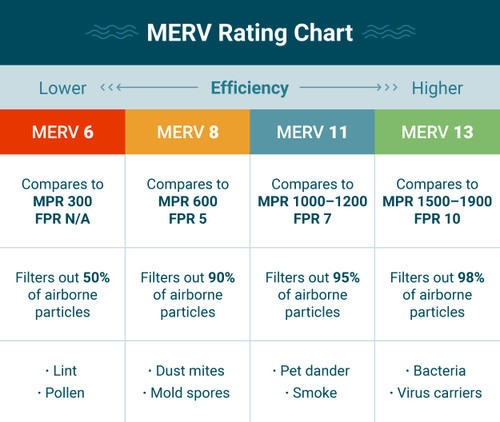What Is a Merv Rating?
What Is a Merv Rating?
The Unites States Environmental Protection Agency defines a MERV rating as a filter’s ability to capture larger particles between 0.3 and 10 microns. Reference this helpful chart here.
MERV (Minimum Efficiency Reporting Value) standardized the way that our industry reports filtration efficiencies. By efficiency, that tells us how much dust a filter can capture at certain particle sizes. In general, as the number gets higher on the MERV chart, the filter is more efficient. Excluding HEPA filters (highly efficient, non-cleanable) the range goes from MERV1 to MERV 16.
A way to measure the efficiency of your filter
Understand that in dust collection, we are primarily using filters that can be cleaned via the use of some sort of back-pulse of compressed air. As of now, this puts most of our filters in the MERV 11-16 range. We want the most efficient (captures the most dust) filter we can offer that still can self-clean and last a long interval of time. We could put in a MERV 17 filter (which is a HEPA filter), but if we can’t clean it then you would have to change the filter every day, which does us no good in dust collection.
Other ways to determine the effectiveness of your industrial filter
By weight
Some manufactures might say their efficiency is 99.99% at 0.3 microns. That sounds great until you realize it is by weight. That might mean the filter is nearly 100% efficient at capturing 10-micron dust (like cement) but 10% efficient at capturing small particles (like smoke).
By Micron Size
Another way to determine the efficiency of your filter is by micron size. For example, 99.9% efficient at collection all particles bigger than 1 micron.
By dust spot or filter cake
Some filters gain efficiency over time. There may be an initial dust spot efficiency (or the amount of dust they capture on day one) and a final dust spot efficiency (the amount dust they capture on the final day of operation. In dust collection, most filters use the dust being captured (or dust cake) to make the filters more efficient. In other words, the dust on top of the filter media acts as another layer of filter.
The most important factor when buying a filter
So, what’s the value in all this information? Pay attention to the ratings on the filters you put in your dust collector. It matters and it could keep more money in your wallet in the long run. Contact Filter Junkie, your filtration experts, if you need help understanding the ratings or selecting the proper filter for your application.



